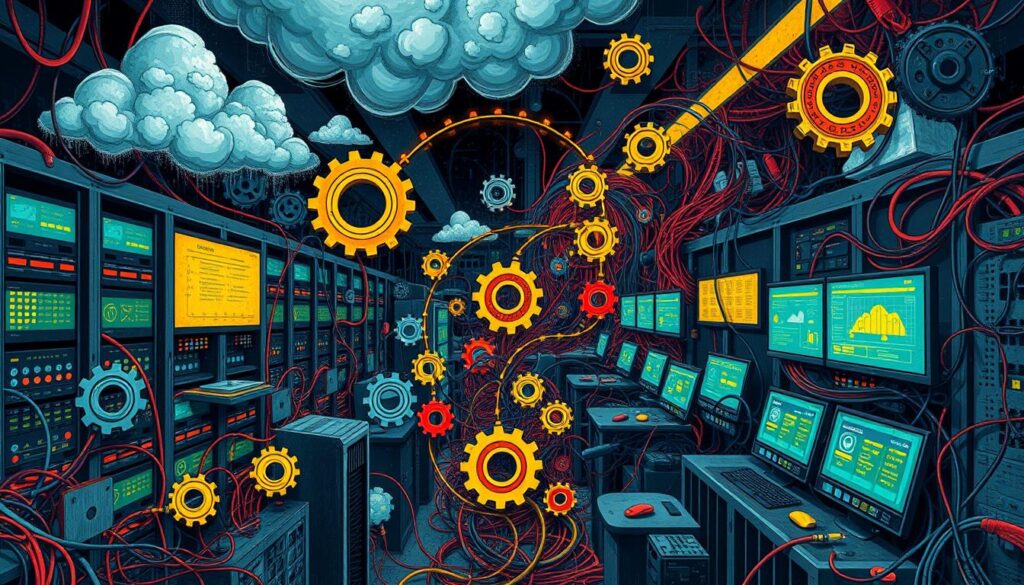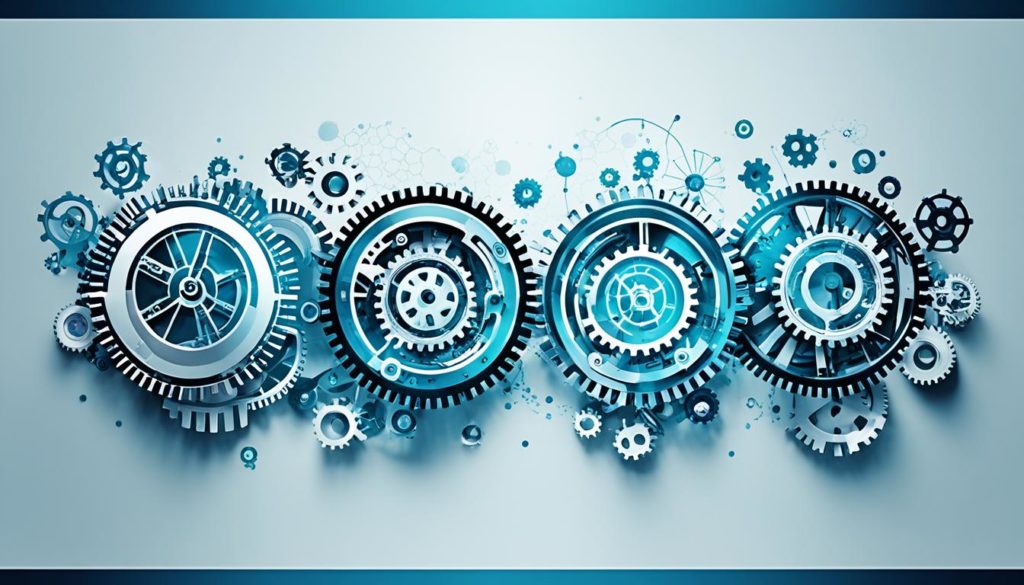
Did you know Google started Site Reliability Engineering (SRE) in 2003? It has become very important over the years. In today’s world, where systems must perform well, SRE is key for companies.
By using automated tests, watching systems closely, and handling problems quickly, businesses can make their systems strong and efficient. This makes customers happier and reduces risks. So, SRE is vital in the fast world of software development.
Key Takeaways
- Site reliability engineering is crucial for system performance and reliability.
- Google SRE principles have been foundational since 2003.
- SRE best practices include automation, monitoring, and incident management.
- Effective SRE leads to enhanced customer satisfaction and minimized operational risks.
- Adopting SRE enables businesses to maintain robust and efficient systems.
The Fundamentals of Automated Testing in SRE
Automated testing is key in Site Reliability Engineering (SRE). It boosts system resilience. SRE uses both old and new testing methods to make systems reliable and release updates faster. Knowing the basics of SRE tools and methods helps us reach operational excellence.
Unit Testing: Building Blocks of Reliability
Unit testing is the base of reliable systems. It checks if each part works right before they’re all put together. This way, we avoid problems in production and keep systems stable. These tests build trust in our systems, pushing the SRE automation forward.
Integration Testing: Verifying Interactions
Integration testing is key for finding issues in how parts work together. It looks at how units depend on each other and their settings. This testing is crucial for keeping system interactions reliable and consistent, using advanced SRE tools.
Stress Testing: Pushing the Limits
Stress testing checks how our system handles extreme situations. It shows us how well our system performs under heavy use. This testing helps us prevent failures and make the best use of resources.
To learn more about these methods and their role in reliability, check out this detailed guide.
Leveraging AIOps to Enhance SRE Practices
Using AIOps in Site Reliability Engineering (SRE) brings big benefits. It changes how we work by using machine learning and automation. AIOps helps SRE teams by cutting down on mistakes caused by tiredness.
It also makes it possible for systems to work on their own. This lets SREs focus on keeping things running smoothly. They become key protectors of IT systems, making sure everything works well without any surprises.
Proactive Monitoring and Incident Resolution
AIOps is great for keeping an eye on things and fixing problems fast. It spots oddities and patterns quickly. This means SRE teams can act fast, cutting down on downtime and making systems more reliable.
Adding smarts to automation means services get better over time. This leads to a more stable and reliable digital world.
- Reduction in alert fatigue through intelligent alerting systems.
- Faster incident resolution by identifying root causes quickly.
- Continuous software quality improvements using operational data for testing.
Optimized Capacity Planning and Predictive Analytics
AIOps also shines in predictive analytics. It helps predict problems and plan resources better. By looking at past and current data, AIOps gives SRE teams key insights.
This proactive approach boosts system performance. It also makes sure resources are used well, avoiding problems from using too little or too much.
| Benefit | Impact on SRE |
|---|---|
| Reduction in Alert Fatigue | Ensures meaningful alerts, preventing overwhelm. |
| Faster Incident Resolution | Minimizes downtime, increasing system uptime. |
| Enhanced Capacity Planning | Optimizes resource allocation based on predictive insights. |
| Improved Software Quality | Continuous improvements by leveraging operational data. |
Bringing AIOps into SRE monitoring and alerting makes things better. The use of predictive analytics boosts digital infrastructure reliability. It opens the door to new and smart ways of working in IT.
Addressing Challenges in Site Reliability Engineering
Implementing Site Reliability Engineering (SRE) in an organization is not easy. It faces many challenges, especially in automated testing. Cultural and technical adoption difficulties also add to the complexity.
Challenges with Automated Testing
Automated testing is crucial for digital service reliability. Yet, it has its own SRE challenges. Managing false positives is a big issue. Sometimes, tests report non-existent problems, causing confusion and wasting time.
Keeping these tests up-to-date is a continuous task. It requires constant updates and attention. This slows down delivery pipelines, affecting SRE efficiency.
According to Dynatrace, SREs spend half their time on automation and reliability. Despite this, automated testing difficulties are a major hurdle.
Adoption Difficulties
Adopting SRE practices is also challenging. Cultural misalignments are a big issue. A cultural shift is needed, focusing on collaboration and business-centric SLOs. Without this, SRE integration is hard.
Technical challenges add to the problem. Integrating new tools and methods requires overcoming learning curves and change resistance. Organizations need to make strategic adjustments and use effective change management. Providing resources, like competitive salaries and growth opportunities, helps overcome these challenges and keep top talent.
Deeper insights are key to tackling these complex challenges. Here’s a table comparing key challenges and solutions:
| Challenges | Solutions |
|---|---|
| Automated Testing Difficulties | Robust test suite management and frequent updates |
| Cultural Misalignment | Cultural transformation focusing on collaboration and SLOs |
| Technical Hurdles | Strategic adjustments and robust change management |
| Retention Issues | Offering competitive salaries and growth opportunities |
Overcoming Common SRE Blockers
Adopting Site Reliability Engineering (SRE) practices can face big hurdles. Two key ways to overcome these are to align SRE with the wider industry and to use a top-down approach. This approach helps get everyone in the organization on board.
Aligning with Industry Context
For SRE to work well, it must fit the unique needs of each industry. For example, finance needs strong security and compliance, while tech focuses on scaling fast and being always available. By matching SRE to these needs, we improve reliability and service quality.
| Industry | Primary Focus | Key SRE Factors |
|---|---|---|
| Finance | Security & Compliance | Robust Incident Management, SLAs |
| Tech | Scalability & Availability | High Availability, Elastic Infrastructure |
| Healthcare | Data Integrity & Accessibility | Data Quality, Redundancy Measures |
It’s vital to match SRE with the industry’s needs. Leonid Belkind said that having set processes for managing incidents is key. Dongfang Xu also pointed out the importance of good capacity planning to avoid problems and meet service level agreements.
Top-Down Approach
To build a culture of reliability, leadership must lead the way. A top-down approach ensures SRE practices are adopted at all levels. Leaders are crucial in getting everyone on board, providing resources, and pushing for SRE certifications.
- Set clear reliability goals that match business aims.
- Support ongoing learning and improvement with SRE certifications.
- Encourage open communication and teamwork across departments.
Ravi Lachhman said reliability is a team effort. By adopting a top-down approach, we can make reliability a core part of our organization. This leads to more stable and reliable systems.
Conclusion
As we conclude our journey into Site Reliability Engineering (SRE), it’s clear that adopting SRE practices is a game-changer. These practices, like automated testing and AIOps, greatly improve an organization’s reliability and efficiency.
Big names like Google, Amazon, and Netflix have seen huge benefits from SRE. They focus on preventing problems and quickly fixing any that do happen. This approach helps keep systems running smoothly and improves user satisfaction. By keeping systems up and running, businesses protect their reputation and keep sales steady.
Automation plays a huge role in SRE. It helps systems grow without a hitch and cuts down on time lost after problems arise. This quick fix ensures systems stay strong and reliable. To really get the most out of SRE, companies need to keep learning, be open to change, and work together. As we move forward in SRE, using these methods will help us tackle new tech challenges and achieve lasting success.
FAQ
What is Site Reliability Engineering (SRE)?
Site Reliability Engineering (SRE) focuses on making systems work well, stay up, and be reliable. It comes from Google’s practices. It uses automated tests, watches systems closely, handles problems quickly, and uses AI to improve things.
What are some of the core principles of Site Reliability Engineering?
SRE’s main ideas are making reliability a top goal, using automation, testing systems under stress, watching them closely, and being ready to handle problems.
Why is automated testing important in SRE?
Automated testing is key in SRE because it makes systems stronger, checks if parts work together right, and finds problems before they happen.
What is AIOps and how does it benefit SRE?
AIOps uses data and AI to do IT tasks automatically. It helps watch systems better, predict problems, and fix them faster.
What types of automated testing are crucial for SRE?
Important automated tests for SRE are Unit Testing, Integration Testing, and Stress Testing. Unit Testing checks parts, Integration Testing checks how they work together, and Stress Testing sees how they handle tough situations.
What are the common challenges in implementing automated testing?
Challenges include dealing with false alarms, keeping tests up to date, and overcoming cultural and technical barriers. These can slow down work and make things less efficient.
How can we effectively address SRE adoption difficulties?
To overcome SRE adoption hurdles, make strategic changes and manage changes well. Make sure everyone understands SRE and that leaders guide the way.
What role does proactive monitoring play in SRE?
Proactive monitoring is key in SRE because it catches problems before they cause trouble. It makes systems more reliable and improves service quality.
How can predictive analytics improve SRE practices?
Predictive analytics help see future problems, plan better, and use resources wisely. This makes operations smoother and systems more reliable.
What is the significance of aligning SRE with industry context?
Aligning SRE with the industry makes sure efforts tackle real challenges. It boosts reliability where it’s most needed and brings real business benefits.
Why is a top-down approach important in SRE?
A top-down approach is key to getting everyone in the organization to support SRE. It makes reliability a goal for everyone, from top to bottom.
Future App Studios is an award-winning software development & outsourcing company. Our team of experts is ready to craft the solution your company needs.










